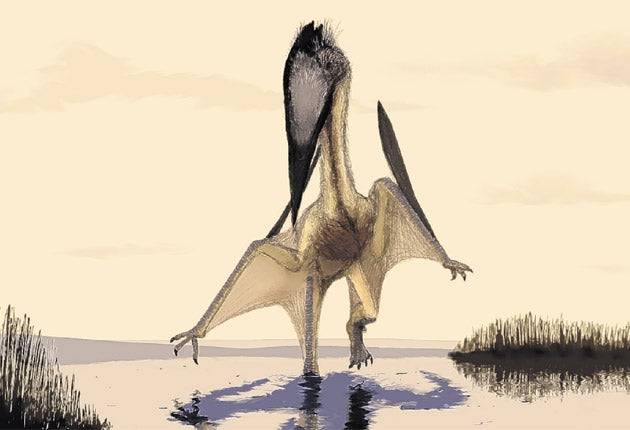Fossil reveals how pterosaur fell to earth – with a hop
Ancient tracks found in France show the Jurassic reptile landing like a modern bird

A short strip of ground where a pterosaur once landed in search of a meal has been found frozen in time in petrified mud. When it touched down 140 million years ago, the Jurassic reptile's feet pressed into soft mud to leave prints which fossilised and have now been identified.
The preserved footprints have revealed that the pterosaur stalled in the air moments before touching down – using the same technique employed by many modern birds.
Scratch marks in the fossilised mud from its claws show that the speed of approach was slightly too fast to come to an immediate halt and that it made a small, ungainly hop before coming a complete stop. But its ability to stall its flight to control the landing indicated the pterosaurs were "strong, manoeuvrable flyers" and that they had mastered a skill still used by birds 140 million years later. This is the first time that scientists have been able to pinpoint footprints made by the ancient reptiles as they came in to land.
They were among hundreds of tracks left by pterosaurs, dinosaurs, invertebrates and other Jurassic creatures at Crayssac in France. An international team of researchers analysing tracks realised that one set of prints belonged to an animal coming in to land and showed them how it would have moved.
The prints reveal that, having touched down safely and folded its wings, the pterosaur turned slightly and wandered off in search, scientists believe, of food.
"It's pretty cool," said one of the researchers, Kevin Padian, professor of integrative biology and curator of paleontology at the University of California, Berkeley, in the US. He said the size of the prints suggests the pterosaur had a wingspan of about a metre, and he added: "We think they were perambulating the beach looking for invertebrates to feed on."
The flying reptile could walk, using its wing arms as a pair of front legs, in a manner more similar to birds and mammals than to modern lizards.
Of particular interest to the research team was the short distance the pterosaur needed to come to a complete halt – less than 25cm – which indicated it had lost most of its speed before touching the ground.
In their report on the tracks, published today in the journal Proceedings of the Royal Society B, the researchers said: "The elongated claw impressions... and the absence of tracks behind this preserved series indicate quite strongly that the animal was landing...
"The short distance between the first and second sets of pes [rear] prints recalls a short and immediate 'stutter step', perhaps a simultaneous hop with both feet. At this point the animal stopped and rested its forelimbs on the ground.
"The arrangement of prints excluded the possibility of a running landing, such as some ducks and seabirds prefer today, but supported the idea that most of the forward motion had been lost in an aerial stall. We infer that, like most birds, these pterosaurs used their wings to stall before landing," concluded the scientists.
Join our commenting forum
Join thought-provoking conversations, follow other Independent readers and see their replies
Comments
Bookmark popover
Removed from bookmarks